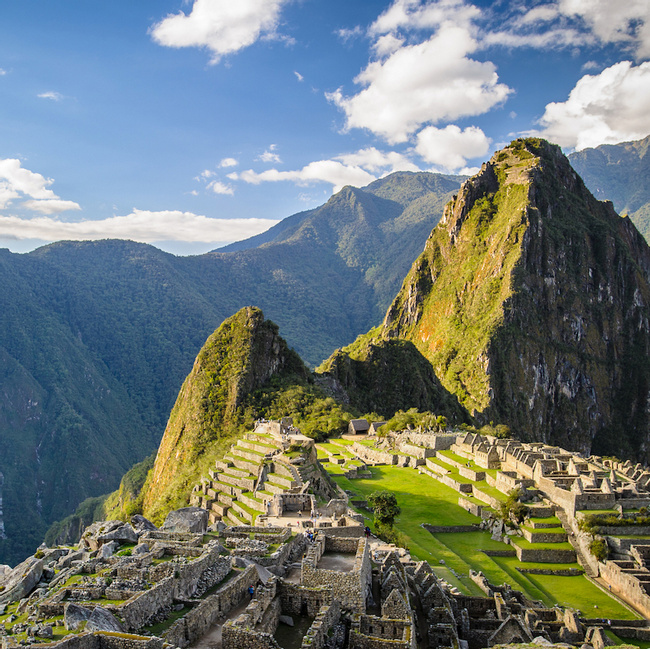- Travel Guides
Music and Art in Peru
Peruvian art is often viewed through the lens of Spain’s influence, in two stages. First, the native handicrafts–woven, intricate designs, and elaborately sculpted ceramics–the true art forms of the Andes. Then the second phase, the neo-baroque and Gothic influence of Spain, and Catholic religious art, an integral part of the colonization that began in the early 16th century. In the resulting mix, European styles and art forms permeated with the artistic sensibilities of the locals.


Influence
Yet there is no linear progression – Andean textiles woven in the pre-Columbian tradition and Spanish architecture coexist to this day, especially in Lima. Ancient Andean art forms are still fodder for contemporary artisans, such as Pablo Seminario and Marilu Behar’s work in their famous ceramic workshop in the Sacred Valley of the Incas. Their highly sought-after style is based on the ceramics of the original inhabitants of the Andes. The imposing, baroque buildings that the Spanish left behind are now monuments to the Peruvian struggle to wrest their identity from a colonial power, and older, Andean art forms point the way forward for a large portion of contemporary craftsmen and artists.
Select Peruvian artisans create textiles using the same methods as their predecessors. Cloth starts with the wool of llamas and alpacas, dyed with plants, minerals and dried insects. The time-intensive process involves twisting the raw wool into yarn using a drop spindle, then weaving it into fabric on wooden looms. Geometric patterns represent the sun, stars, rivers, and mountains. Occasionally, a stylized bird or other animal enters the mix.
First the Chavín and then the Moche people of the Andes developed the distinctive style of weaving that is still popular in Peru today. Chavín art has distinct, geometric patterns. Moche artistic traditions have also survived to present generations. Their ceramics depict stylized, twisting plants and animals. Inca artists drew on the influence of the cultures that they conquered. You don’t have to be an archaeologist to recognize the similarity between the open-mouthed, wide-eyed, anthropomorphized animals of the Chavín and the Inca. To observe pre-Columbian arts and textiles for yourself, be sure to visit Museo Larco and Museo Amano while you’re in Lima. To see pre-Columbian art displayed in its original context, make a visit to the Museo de Sípan, on the west coast. Built as a reconstruction of a fully intact tomb of a Peruvian ruler discovered in the 1980s, this museum conveys the full artistic force of the pre-Columbian peoples.
Escuela Cusqueña is one the most notable art movements to come out of the combined forces of indigenous and European tastes. During the late 16th century, artists came to Peru seeking commissions. One such artist, Bernando Bitti, came to Peru and set up a workshop to train native Peruvians to paint in the Baroque style. Most famously, this school produced The Last Supper by Marcos Zapata, a painting that still hangs in the Cusco Cathedral. In it, Jesus and the apostles eat a tradition Peruvian feast of guinea pig (still a source of protein in some parts of Peru) and chica, Peruvian beer made from corn. Through Catholic iconography, Peruvian artists included elements of their own history. In one of the murals at the Cusco Cathedral, archangels were depicted with muskets and wearing distinctly Spanish clothing.
Post-colonization, European artistic movements found their way to Peru. Some Peruvian artists found a home in European art movements. In the 19th century, Ignacio Merino joined the Romantics and created a series of watercolors based on the life of Christopher Columbus. Carlos Quizpez Asin, an artist of the 20th century, gained national renown from his participation in the European postmodern movements. Pablo Picasso’s influence is evident in much of his work.
If you can only make it to one museum during your stay in Lima, Museo de Arte de Lima (MALI) might be your best bet for covering all the bases. It features pre-Columbian, colonial, and contemporary galleries. These collections are housed in a building that was constructed in the late 19th century. The building has a stately style that is not often seen in Peru outside of Lima.

Music
For thousands of years, the Andes have reverberated with the high-pitched notes of the native pan flute, known as a zampoña, accompanied by a drum. Nowadays, the traditional ensemble of música fólklorica has expanded to include a charango–lute made from armadillo shell. This ensemble, accompanied by flutes, harps, and loud singing, makes huayno, a prominent style of Peruvian folk music.
During the 20th century, the musical style of música criolla took the native musical traditions and expanded them to include newer traditions from around the world. Peruvians have their own version of the blues, known as landó, born out of the African population brought to Peru by the Spanish.
Africans also brought cumbia, a musical style that started out as an accompaniment to a courtship dance. In Peru, it combined with elements of huayno and modern psychedelic rock to make chicha, a uniquely Peruvian sound growing in popularity all over the world.
Make your next vacation a cultural adventure; if you go to Peru during some of the country's most celebrated festivals and holidays, you will be able to absorb the full spectrum of art, music, religion, history and culture.
It's more than just having a good time or visiting beautiful places (although that's absolutely a part of it!), it's about being part of a unique experience that stays with you.



